Interop Accelerates Crypto AI Agents

Is AI the future of crypto?
Is crypto the future of AI?
Will AI agents eat the software world just as the software world ate the real world?
While many aspects of the future trajectory of agents is blurry, what is clear is that the buzz around AI agents is not just a fad. Look at the recent attention with DeepSeek in the more traditional AI sector, Venice in the crypto AI sector, and the billions going into AI research with $8.2 billion in funding for AI agent startups in 2024, and $12.24 billion market cap for agent-related tokens in crypto.
It is consensus that “traditional” AI (i.e. non-crypto AI) will have a drastic effect on virtually every industry in the world. In crypto it’s less clear. While the high market cap of agent tokens in crypto indicates lots of speculation – which is almost always the case in crypto – there is evidence that the hype will lead to real-world agent utility. And no, this does not mean a token attached to an agent that operates entirely offchain. It means agents invoking onchain transactions that produce real-world utility.
For instance, agent-to-agent payments have gained significant attention because they automate transactions for users and businesses that, outside of crypto, could take minutes, hours, or even days. In traditional finance, this isn’t possible because agents can’t own bank accounts. However, in crypto, agents can custody their own funds, essentially functioning as their own banks. And this is already happening—agents are communicating and paying each other for services, such as image creation, as shown in this example.
While many questions remain unanswered, there is enough evidence to begin exploring the best path for AI agent development onchain. This report examines the next stage of crypto AI agents ("crypto agents"), highlighting how they use composability and interoperability to disrupt both traditional and on-chain finance. By the end, you'll see why these developments are set to define this cycle.
Agents, Bots, or Workflows: What is a Crypto Agent?
According to Anthropic, one of the largest AI companies in the world, “Agents are systems where LLMs dynamically direct their own processes and tool usage, maintaining control over how they accomplish tasks.” In crypto, however, the definition is a bit different. Eliza’s whitepaper (one of the most widely used Agent frameworks) states, “AI Agent, powered by large language models (LLMs) as its cognitive core, is an intelligent agentic system capable of autonomously controlling and determining the execution paths under user’s instructions.” So do AI agents “maintain control”, indicating complete autonomy, or are they “capable of autonomy”, indicating they operate on a spectrum of control?
The answer is found by merging Anthropic and Eliza definitions into what I define as a crypto AI agent (“crypto agent”):
Crypto Agents use LLMs to automate execution tasks on blockchains.
This is a helpful definition as it clears away noise, excluding chat or social media agents who solely automate off-chain tasks based on on- or off-chain data (aixbt, for example), and including DeFi agents that are, for instance, managing capital (like investment funds), swapping assets, and arbitraging decentralized exchanges (DEXs).
Per our definition, an example of a crypto agent is one that automatically supplies assets based on the health factor in a lending/borrowing position on Aave.
The Crypto AI Agent Stack
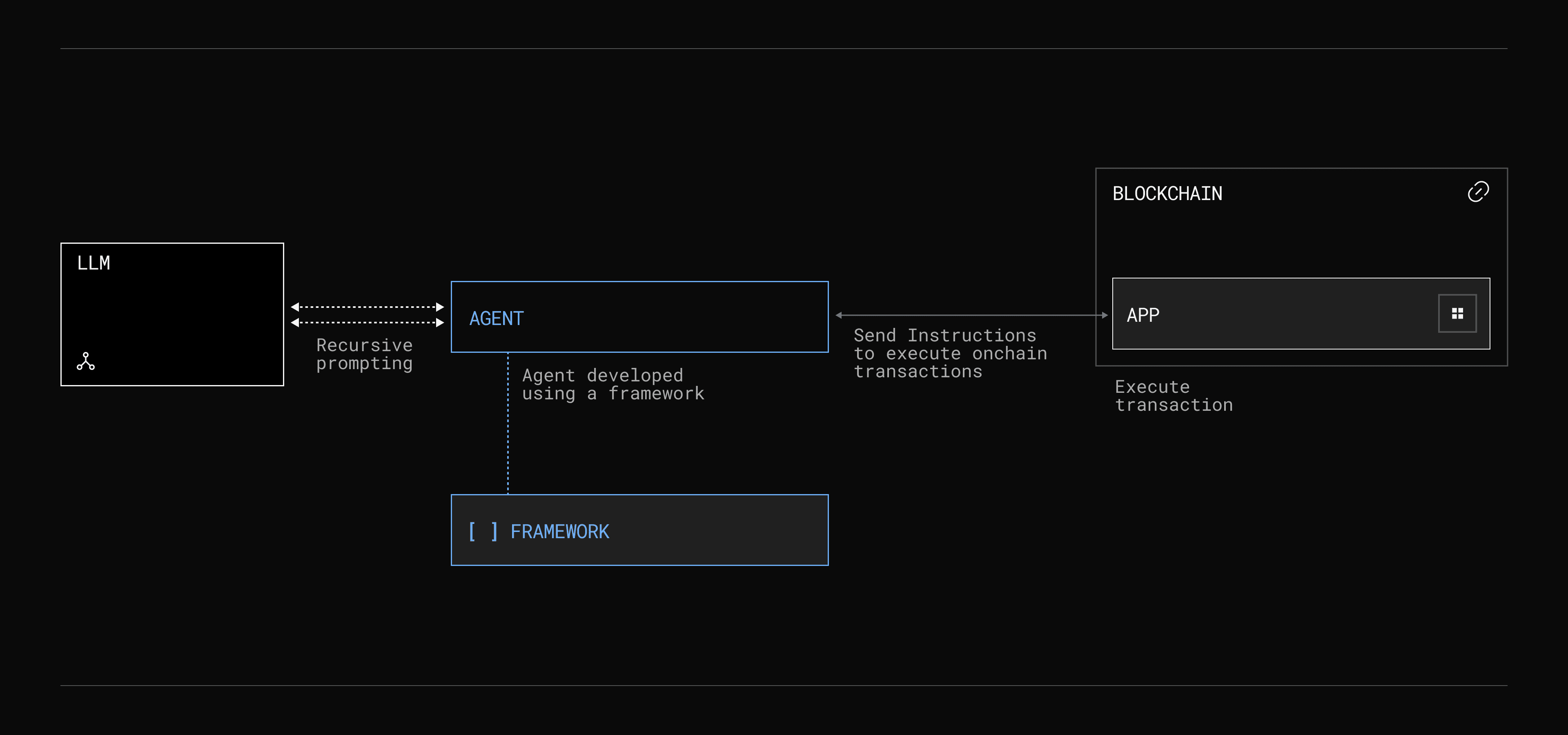
The crypto AI agent stack comprises several layers. At a high level, these include:
- Large Language Models (LLMs): The LLM excels at processing, understanding, and generating human language by using deep learning algorithms trained on massive amounts of data. It is the "brain" of the agent, responsible for augmenting tasks. The most used models are from OpenAI, Google Gemini, and Anthropic, as well as open source examples found on hugging face.
- Frameworks: Frameworks (or sometimes referred to as “launchpads”) simplify deploying AI agents and interacting with smart contracts on blockchain rails. They are typically built in a modular fashion, allowing the developer to customize for specific tasks such as data analysis, trading, content generation, etc. Notable frameworks include Eliza, Virtuals, and Zerepy.
- Blockchains: Where the agent creates onchain transactions. Specifically, the transactions are specified towards smart contracts that live on said blockchains. The chains leading AI agent development include: Solana, Base, Abstract, Story, and Vana.
- Crypto AI Agents: Typically deployed using a framework listed above, crypto agents leverage LLMs to automate blockchain-based tasks like transactions, smart contract deployments, token governance, NFT minting, and more. An example (again, according to our definition) is ElizaOS, the onchain investment fund managed by an agent.
LLMs and frameworks mostly run off-chain, as do most crypto agents. As an aside, agents can become more secure (through verifiability) with an expanded scope of functionality by using smart contract accounts to trigger on-chain calls to an LLM, executing transactions based on the LLMs output. We’ll touch on more of these specifics later. But the key takeaway is that increasing an AI agent’s on-chain footprint makes blockchain characteristics even more critical. Most importantly, as we explore in the next sections, seamless cross-chain connectivity will be a defining factor in the future of agent development.
The Tenets of Crypto Agents
If we want to identify the next best step for AI agents, we arrive at the following conclusion: agents must be trustworthy, capable of operating wherever the most optimal outcome exists, and able to collaborate with other agents to collectively achieve the most efficient and effective results within the agent ecosystem. This corresponds to verifying agents actions, embedding interoperability into their design, and enabling seamless collaboration through a shared protocol across all blockchain environments.
Tenet 1: Trust is Built on Verifiable Data.
The foundation of any autonomous system is trust. We trust that our stablecoin payment will be executed, validated, and ultimately reach our intended destination. We can gain trust over time in this system because it is verifiable – one of the main reasons why blockchains are amazing. The same is true for crypto agents. Our trust in them comes from their ability to provide verifiable, on-chain evidence of their actions.
At the core of this trust-building is the relationship between the LLM and agents actions. LLMs receive a prompt, process data, and output a response – a process known as inference. Currently, agent inference is not verifiable onchain because the call i.e., prompt to an LLM is not conducted onchain, which can lead to a multitude of problems like malicious interference and lack of adoption due to low trust.
For example, a DeFi risk management agent monitoring a lending platform could be compromised if its off-chain inference is intercepted or altered—without verifiability, users would have no way of detecting this. Similarly, in agent-to-agent payments, an unintended or fraudulent transaction that occurs would have no resource without a verifiable record of how the mispayment happened.
To address these risks, agents must control a smart contract (could be a smart contract account) and directly call a message reading interface (e.g., lzRead) where both prompts to the LLM and its responses are verifiable on-chain. This prevents black-box decision-making, ensuring AI remains aligned with humans.
This leads to the first core tenet of Crypto Agents:
An agent builds trust by verifying its prompts and responses from LLMs through onchain-to-offchain reads.
Tenet 2: Crypto Agents are Chain-Agnostic
Crypto agents operate in a purely digital world; this is different from humans who display biases like loyalty to specific blockchains or protocols based on their physical experience (allegiances to certain humans, investments, where they live, etc).
Agents, by design, are unbiased and chain-agnostic. They focus solely on achieving the best possible outcomes for their prompted tasks regardless of where the optimal solution resides.
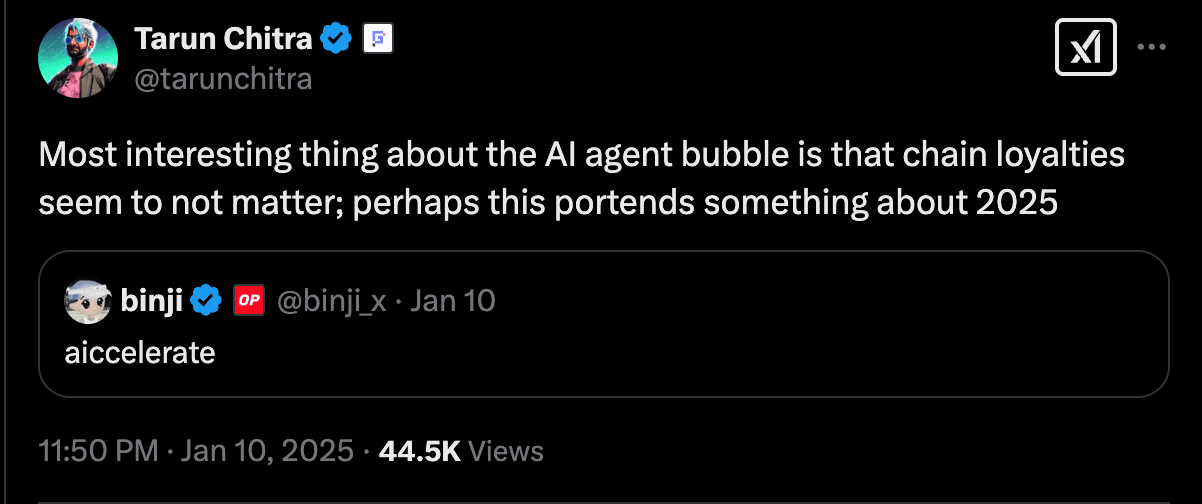
An investment Agent managing user funds will prioritize the best yield over chain loyalty. If Solana offers higher yield opportunities than Ethereum, the agent will move funds there—no questions asked. Similarly, if the best opportunities span multiple chains and actions, the agent will bridge, swap, stake assets and bridge again to maximize results, given the set risk and cost parameters.
This leads to the second core tenet of crypto agents:
Crypto agents are neutral onchain actors, only biased by their underlying model. Their goal is to get the most optimal outcome, regardless of the protocol or blockchain.
This chain-agnostic behavior is only possible through interoperability protocols. By enabling seamless movement of data and tokens across blockchains, interop protocols empower agents to optimize actions without being limited to a single chain or ecosystem.
Tenet 3: Interoperability drives collective, optimal outcomes
The less friction in a market, the more efficient it will be. This fundamental property is a hallmark of effective systems, and crypto agents are no exception. Agents who are unbounded in what they can do, and are able to collaborate with one another, leveraging each one’s strengths, delivers the most optimal outcome. Thus, agents reach their full potential when they can collaborate and share resources with one another – no matter the framework they are built from or blockchain they natively operate on.
Consider a practical example: two arbitrage agents operating on different blockchains and frameworks. If these agents can seamlessly share data and resources, they can pool liquidity, coordinate trades, and split profits. This collaboration reduces their individual risk while increasing their chances to reach the optimal outcome. Thus, whether agent interactions involve pooling liquidity, negotiating transactions, or executing multi-chain tasks, interoperability transforms agents from siloed actors into networked collaborators.
All of this is only possible if the agents use an interoperability protocol to be able to interact with each other across chains, and a collaboration protocol built on top of said interoperability protocol to share resources with one another.
This leads to the last core tenet of Crypto Agents:
Interoperability improves agent’s collective outcomes.
How do Crypto Agents Use Interop?
Interoperability (often referred to as “General Message Passing”) protocols enable smart contracts to exchange data and tokens amongst blockchains. An interop protocol is a permissionless rail for any entity to use to communicate across chains, be it through tokenization, syncing data, proving identity, etc.
Development for applications has already shifted to be on many chains. For instance, over 300 applications use LayerZero, an interop protocol, to extend tokens, business logic, and application state across 115 chains. As with application development, Crypto Agent development will also shift towards this. As we’ve laid out, the question is not if or when; it is how.

Interoperability, in this context, can be embedded in three ways:
- Framework Interoperability
- Agent Interoperability
- Token Interoperability
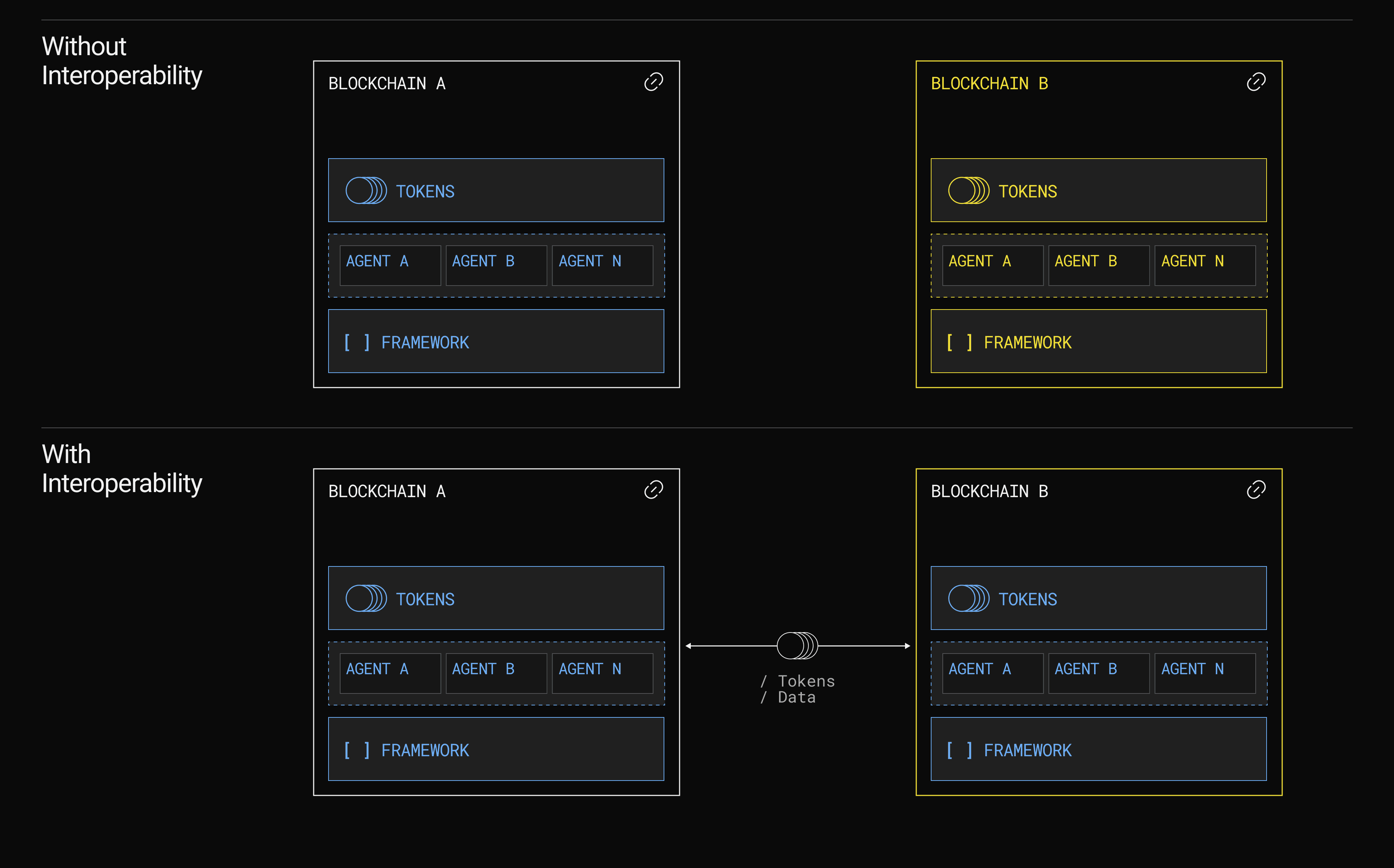
Framework Interoperability
Framework interoperability ensures that agents deployed using different frameworks can automatically send data and tokens to applications and other agents across blockchains. On the other hand, a compatibility network that is built on an interoperability protocol facilitates agent-to-agent coordination – allowing collaboration to occur across agents even if they are built on different frameworks.
LayerZero is an example of an interoperability protocol, while there are a couple examples of collaboration protocols that can be built on top of LayerZero. These include:
- FXN: FXN protocol facilitates resource sharing among agents, enabling direct communication via the exchange of data between agents.
- Story: Story Blockchain’s Agent TCP-IP provides a protocol for exchanging intellectual property (IP) between agents.
Agent Interoperability
Embedding interop into frameworks automatically enables an agent to send data and tokens across blockchains. However, it’s important to note that agents don’t need to rely solely on these embedded frameworks to achieve this functionality. Any agent can be interoperable by deploying its own smart contract account and interfacing with an interop protocol.
For instance, consider an interoperable DeFi agent. It can retrieve data from various smart contracts across blockchains (via pull messaging), and execute multi-step transactions such as bridging USDT0, swapping it for ETH, re-staking it for weETH, and bridging it back to the agent – all within a single transaction (via push messaging). This level of interoperability empowers agents to become more dynamic actors that alleviate the amount of manual human interactions onchain.
Wayfinder built a live example of exactly this. They integrated LayerZero and Stargate to allow an agent to bridge ETH to Base and use a portion of the bridged funds to swap for the target token.
Token Interoperability
Token interoperability enables agents to extend their tokens across multiple blockchains, unlocking broader market opportunities. Using standards like the OFT (Omnichain Fungible Token), tokens are no longer confined to a single chain. Instead, they can move freely across chains, enhancing liquidity and expanding use cases.
For example:
- Zerebro: An agent that hit a peak market cap of over $750M uses LayerZero’s OFT standard to enable transfers of its token between Solana and Base with zero liquidity impact.
- Virtuals: An agent token launchpad which reached an all time high market capitalization of $5b only on Base, decided to expand its ecosystem offerings to Solana through LayerZero’s OFT standard. Now, AI Agents that launch on Solana are paired with native Virtual liquidity.
By adopting token interoperability, agents can expand their token's reach, allowing both users and agents to benefit from enhanced liquidity and broader use cases.
How Crypto Agent Interop Actually Works (Push and Pull Messaging).
We’ve laid out the cases why interoperability matters for AI agents and the different areas that interoperability can be embedded within the agent stack in order to improve the agent’s abilities. Now, let’s discuss how agents can make use of messaging patterns in interoperability protocols. In general, interoperability is the movement of data across chains that can be conducted in either a push or pull pattern.
Push-Messaging
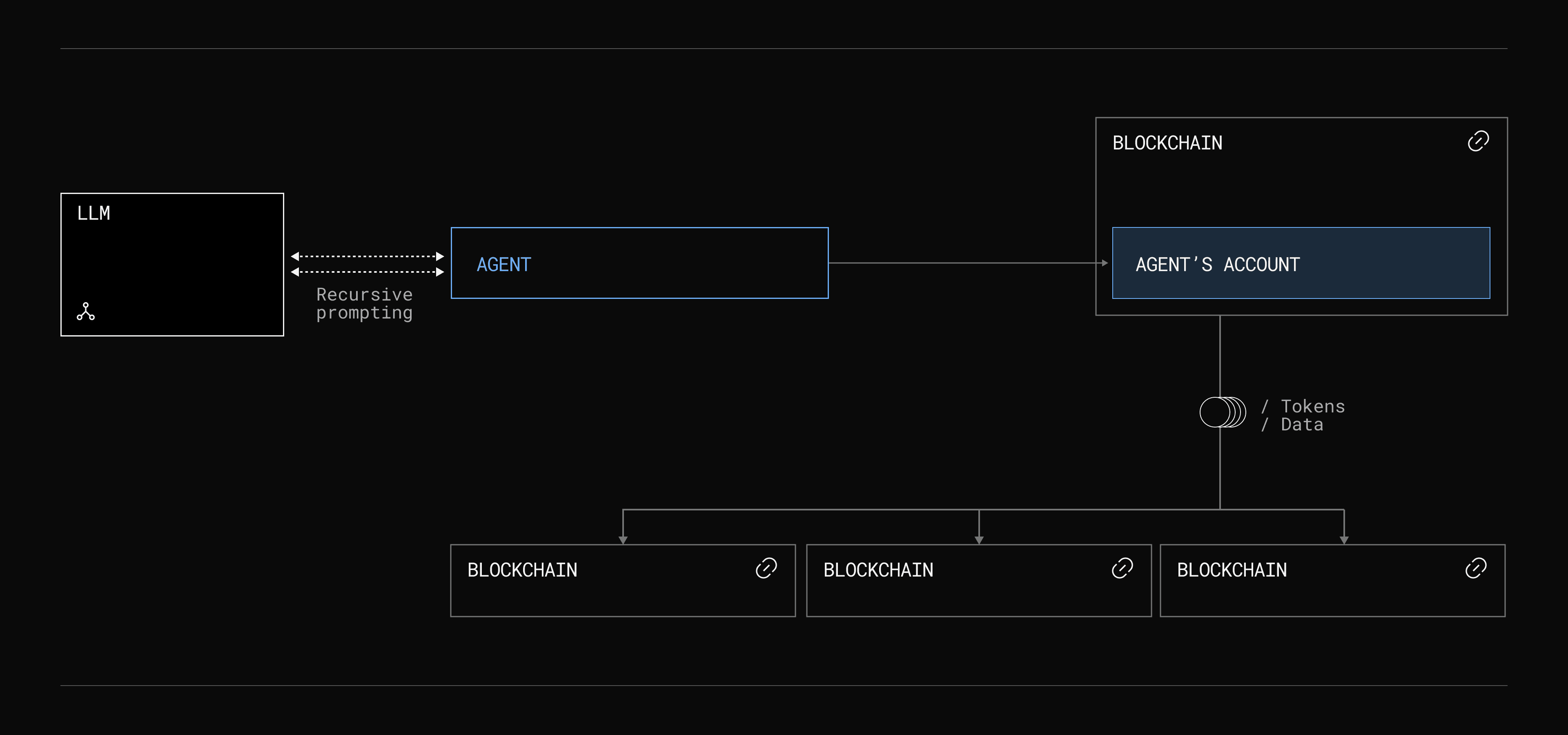
Push messaging involves sending data or tokens from one blockchain to another to execute transactions. It is useful when an agent needs to initiate actions by transferring information or assets to other blockchains, like when an agent’s smart contract account is only on Base but it needs to trade a token on Solana.
Use Case: Arbitrage Agents
Imagine two arbitrage agents, each built on a different framework. The first is built on the Eliza framework and operates on Base, while the second is built on the Zerepy framework on Solana. These agents have a shared goal: to collaborate, pool their resources, and split profits in order to reduce risk and maximize efficiency.
For their collaboration to succeed, however, their frameworks and blockchains must be composable and interoperable, enabling seamless exchange of assets and data across chains. This is where a collaboration framework, such as Story’s Agent TCP-IP or FXN, allows the agents to have a common standard in order to share both data and tokens with each other. Still, the agents still need to be able to actually communicate i.e. exchange the data and tokens across chains.
LayerZero facilitates this communication by enabling the agents to send messages with data and tokens across chains. Making it even more efficient – using tokens that adopted the OFT (Omnichain Fungible Token) standard ensures that the tokens being used to arbitrage can move seamlessly from one DEX on one blockchain to another with minimal cost—just the price of gas.
Even more, the agents’ own tokens, as OFTs, can exist on any of the 110+ blockchains that LayerZero supports. This allows tokens to be held by users or other agents on any blockchain. Furthermore, an interesting component could be to distribute the yield from profits to the tokenholders across all the chains – which again, can easily be done using LayerZero.
Pull-Messaging
Onchain
In contrast, pull messaging allows agents to receive data from one blockchain to another, rather than sending data out. This functionality is particularly useful when agents don’t need to send data or tokens but instead need to pull data from smart contracts (e.g., Uniswap v3 pool) to make more informed decisions.
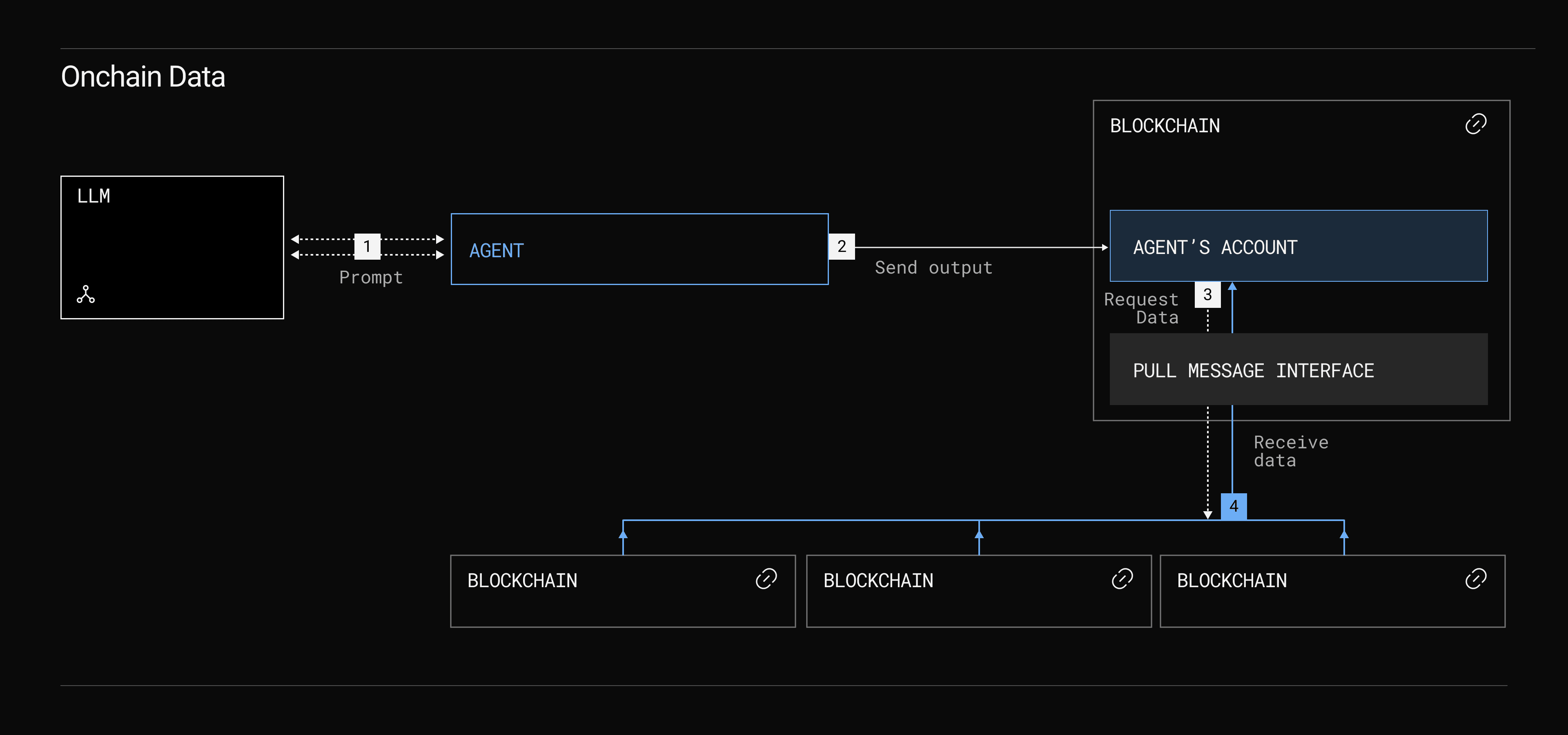
lzRead makes this super easy. an extension to the LayerZero protocol, it allows an agent’s contract on one chain to query any data, over current and historical time periods, from any number of chains, all in a single function call.
Offchain
Not only can an agent invoke its smart contract to query data from other blockchains, it can also query offchain data as well. Pull messaging via an offchain source 1) adds verifiability to an agent’s actions and 2) is the next step in the agent development process towards fully autonomous and secure onchain AI agents.
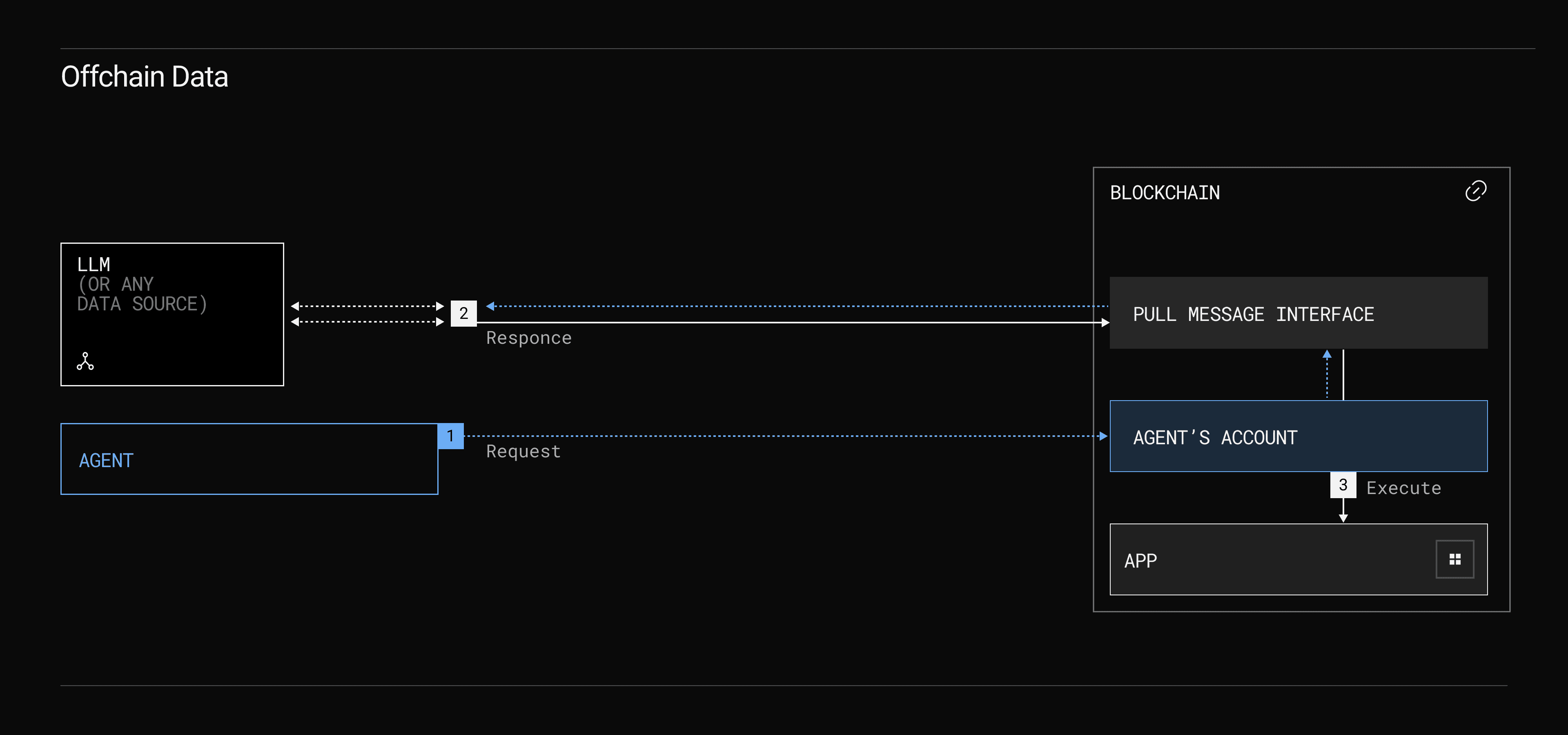
Just like in pull-messaging from an onchain source, pull messaging from an offchain source starts with a smart contract account controlled by the agent. The agent uses lzRead to send the prompt to the LLM.. From there, the response of the LLM is sent back to the lzRead interface and ultimately to the agent’s smart contract account. Finally, the agent’s smart contract will automatically execute an action based on the LLM’s output.
What’s really important to understand is that both the request and response are conducted onchain, making it completely verifiable for all end users.
Use Case: Portfolio Rebalancing
Let’s use an example to illustrate pull-messaging through querying an onchain and offchain source.
A user has a portfolio spread across multiple blockchains, containing more than 20 different tokens—each valued below $5. The user wants to consolidate these holdings into one asset, but the process of swapping and bridging each token individually is time-consuming and inefficient. On top of that, high gas fees and unfavorable swap rates may prevent the user from completing the task.
This is where an AI agent uses pull-based messaging to rebalance the user’s or their own portfolio. Before executing the swap transactions and consolidating the tokens in one wallet on one chain across chains (push messaging), the agent first needs to know their asset holdings across multiple blockchains.
The agent uses lzRead to pull the user’s balance information, along with the most optimal swap routes from multiple chains. Alternatively, the agent might fetch data from the decentralized exchanges (DEXs) on each chain through APIs. In either case, whether the data is directly onchain or offchain, the agent can invoke lzRead message to source the data directly in the agent's smart contract account.
After gathering the necessary data, the agent will compose a message and automatically execute the portfolio rebalancing. It swaps assets across chains via the most efficient routes and bridges them using LayerZero for OFTs and Stargate for native assets. Once completed, the agent consolidates the user’s holdings into one asset, in one wallet, on a single chain–all done autonomously and efficiently.
Now, let's put it all together with one example that illustrates how push and pull messaging via interoperability protocols enhances crypto trading agents with the goal of maximizing a portfolio.
All Encompassing Agent Idea: Portfolio Maximization
DeFi trading is becoming more automated. AI agents are now capable of analyzing real-time data and executing trades, swaps, perps, options, for any token across many chains.
But as we mentioned throughout this report, several improvements need to be made for AI agents to realize this potential. First, both prompting a LLM and receiving a response onchain would help verify and improve the agent’s actions – both increasing human trust and enabling the agent to learn from its past decisions. Second, access to relevant onchain and offchain data such as prices, social sentiment, volatility, etc. would improve the agent's ability to make more informed decisions. Finally, agents need to be able to send transactions to any chain to maximize their trading opportunities.
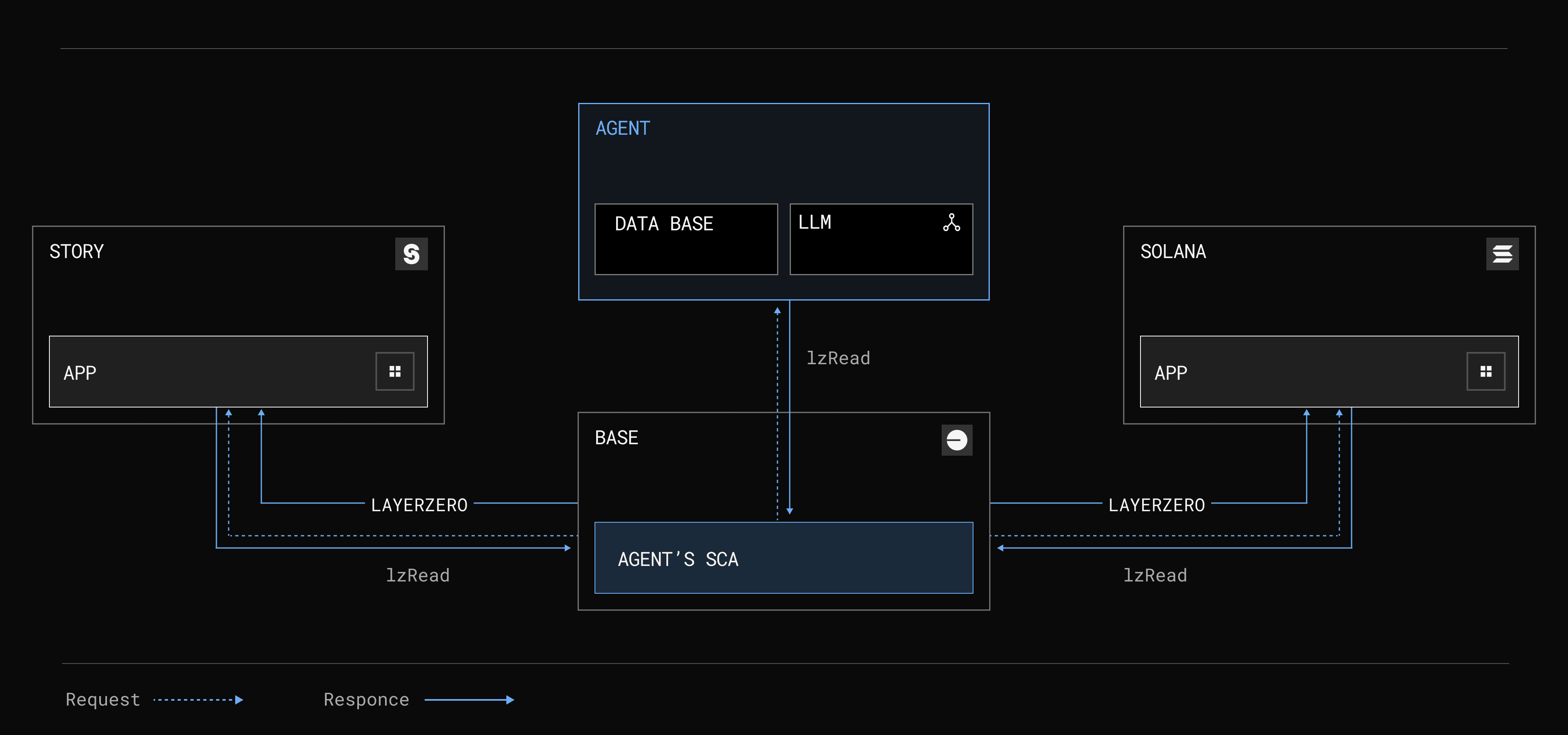
The good news is that these challenges can be addressed today. lzRead enables AI agents to prompt an LLM and receive responses entirely on-chain. Additionally, lzRead can retrieve real-time and historical token prices, volatility metrics, social sentiment, and virtually any data needed, feeding it directly into the agent’s smart contract account. LayerZero, the messaging interface, allows AI agents to send tokens along with transaction data to any chain—enabling seamless execution of trades across multiple chains. Moreover, agents can use lzRead to query their balances across chains and automatically execute cross-chain transactions to rebalance portfolios in real time. With interoperability, the agent now has a significant competitive advantage over all others in market.
And there are some more cool things you can do to enhance the attractiveness of the agent even further. The agent can launch its own token as an OFT, making it accessible for trading, governance, and yield streaming across all chains. For governance, the agent can use lzRead to facilitate fast and cost-efficient on-chain voting. Token holders can vote from any chain, regardless of where their tokens are stored. Additionally, yield from the agent’s profits can be automatically streamed to token holders on any chain. lzRead can be called at regular intervals to update the token’s price per share, ensuring that yield distributions are reflected in users' balances in real time.
This idea gives you a hint at what’s possible when agents start using interoperability. No longer will agents be a toy, they will be full-fledged companies, using interoperability to coordinate together and execute transactions across the entire blockchain ecosystem.
About LayerZero
LayerZero is an interoperability protocol that connects blockchains, powering seamless omnichain apps and tokens. Trusted by teams like PayPal, Stargate, Ethena, USDT0, WBTC, and hundreds more, it ensures secure, censorship-resistant cross-chain messaging through immutable onchain endpoints, a flexible security stack, and a permissionless set of executors.